2011 Ford Fiesta: First Drive
Thanks to Ford’s “Fiesta Movement” social-media marketing strategy, as well as plenty of buzz from American auto journalists who spent time behind the wheel of the car while traveling to Europe, the 2011 Ford Fiesta may have been one of the most-anticipated small cars to hit American soil in some time. Now, we’ve finally had the chance to drive it.
FAST FACTS
| 1. The Fiesta is powered by a 1.6L 4-cylinder with 120-hp and 112 ft-lbs of torque. |
| 2. Ford rates the car’s fuel economy a 29/38-mpg (city/hwy) for the manual, and 30/40-mpg for the six-speed automatic. |
| 3. Models range from $13,320 to $16,320 for the sedan and from $15,120 to $17,120 for the hatch, plus options. |
For those that have been living under a volcanic ash cloud for the past year, the 2011 Ford Fiesta is coming to America to fill in a gap in Ford’s lineup. Ford hasn’t had a B-class car for sale on American soil in a while, and its past efforts have been less than inspired.
Ford is aiming this car squarely at “urban millenials” along with empty-nesters. Don’t know what an urban millennial is? Think single or married without kids, living in the city, and you’ve got the idea.
Before we were giving a chance to drive the car, Ford told assembled journalists that the company expects the market for small cars in the U.S. to grow, no matter what happens to fuel prices. Simply put, Ford is betting big on small cars.
120-HP 4-CYLINDER LESS THAN EXCITING BUT GREAT ON FUEL
This particular small car is available in two flavors—five-door hatchback and four-door sedan. All models are front-wheel drive. A single engine choice is available—a 1.6-liter four-cylinder with Ford’s Twin Independent Variable Camshaft Timing (Ti-VCT). This powerplant makes 120 horsepower and 112 ft-lbs of torque.
Two transmissions are offered: A conventional five-speed manual and a six-speed automatic that Ford dubs PowerShift, due to its lack of a torque converter. The transmission instead uses a dual dry-clutch setup. Paddle shifters aren’t available at the moment.
Ford is claiming fuel-economy numbers of 29-mpg city and 38-mpg highway for the manual, and 30-mpg city and 40-mpg highway for the automatic. EPA numbers have not yet been released.
PRICING STARTS AT $13,320 – HIGH END OPTIONS ARE PLENTIFUL
One way that Ford is hoping to snag customers is by offering features typically found in more expensive cars, such as heated leather seats, advanced keyless entry, a push-button start, Ford’s Sync multimedia suite, and electric power steering.
A variety of trim levels are available: S, SE, and SEL on the sedan, and SE and SES on the hatch. One neat touch: buyers who want custom exterior graphics can purchase them through dealerships.
A set of 15-inch wheels is standard, with 16-inch wheels optional. The Fiesta offers a couple of interesting steering features: Drift-pull compensation, which is meant to keep the wheels straight on grated pavement, and Active Nibble Cancellation (yes, that’s what it’s called), which is meant to filter out irregularities in wheel balance.
The front suspension consists of “specially-tuned” struts, stabilizer bars, bushings, and dampers, while a twist-beam axle does the job in the rear.
Ford claims to have taken a few other steps to make the Fiesta feel more up-market, such as adding soft-touch surfaces to the interior and taking steps to eliminate wind and road noise, such as adding an acoustic windshield and headliner.
Fiesta’s safety features include seven airbags (including a driver’s side knee airbag) and standard AdvanceTrac traction control with stability-control.
Base prices are expected to be $13,995 for the sedan and $15,795 for the hatchback when the Fiesta goes on sale this summer.
DRIVING IMPRESSIONS: FIESTA SEDAN
We had the chance to test the Fiesta on the mountain roads south of San Francisco, starting with an automatic-equipped SEL that had the 301A option package (heated leather seats, chrome moldings on the beltline and decklid, an alarm, and keyless entry and push-button start). Total price: $19,575, including the $675 destination.
It quickly became apparent that 120 ponies and 112 lb-ft of torque aren’t enough on hilly roads, although the engine offers enough power for sedate suburban driving and light highway cruising. When passing or powering out of a corner, the engine often felt like it was out of breath. The lack of paddle-shifters didn’t help.
For its part, the automatic was mostly seen and not felt. The biggest difference is that the tranny is quicker to kickdown to a lower gear than a conventional automatic, and it sometimes holds on to revs a bit longer. Otherwise, it does its business quietly and competently.
It was immediately apparent that the steering was electric and not hydraulic. It’s weighted a bit on the light side, but is accurate and responsive enough in the corners. When pushed, the Fiesta requires some mid-corner corrections, but body-roll is minimized.
Ride quality is mostly pleasant, although this is a small car, so bumps and imperfections are felt. Still, the Fiesta feels smoother than some others in this class.
Interior materials look and feel upscale, and the exterior styling is generally easy on the eyes. The soft-touch dash and armrests are appreciated. We didn’t play much with radio or HVAC controls, but most are easily reachable. The biggest letdown in quality is the headliner, which feels like the packaging on a carton of eggs.
Unfortunately, Ford’s efforts to drown out exterior noise come up a bit short, with plenty of wind, road, and tire noise creeping into the cabin. Same goes for engine noise. Bring the tach above three grand, and you’ll hear the 1.6-liter in all its revvy and buzzy glory. You’ll be hearing it a lot, since the lack of low-end torque means that a fair amount of throttle input is needed to get the car going with urgency.
The seats are generally comfortable, but the bottom cushion comes across as a bit flat. Rear-seat access and legroom are a challenge for adults who are on the tall side—your author is six-one and couldn’t even get into the rear with the front seat all the way back. Moving the front seat forward helped, but then, taller front seat passengers would find their knees touching the glovebox. Speaking of the glovebox, buyers will need to get familiar with it—there is no center console. Three cupholders sit in its place.
Trunk space is ample in the sedan, and headroom and legroom are adequate upfront.
HATCHBACK DELIVERS ADDED FUN
Next up was a hatchback SES with the manual. This car costs $19,305 with similar features as the sedan, but it offers slightly different driving dynamics.
The hatch feels a bit sportier than the sedan, and the manual probably deserves most of the credit for that. The throws are a bit long, and the gates are a little loose, but otherwise, it’s pretty good and like most manuals allows for added access to the engine’s power.
In the first three gears, the car feels a touch quicker under heavy throttle, although it still could use a pinch more power. Fourth and fifth gear are useless for passing—if you need power in a hurry on the highway, select third—but they are fine for cruising.
Handling also feels sportier, although by provoking a more aggressive drive, body roll then becomes a bit more pronounced.
Cargo space in the rear hatch looks to be adequate. Interestingly, Ford hasn’t released any cargo room specs for the car yet, although they’re certain to be close to the Euro-spec model that has 10.4 cubic feet of trunk space or 34.6 total cu.-ft. with the rear seats folded flat. Again, that’s adequate, but roughly half the cargo room of the Fit and far less than the largish Versa.
We were also given the chance to pit the Fiesta versus a Honda Fit and Toyota Yaris on an autocross course and in a lane-change maneuver. The Fiesta acquitted itself well in both challenges, but really, the deck was stacked in Ford’s favor —the Yaris is not meant to be pushed, while the competent Fit’s higher center of gravity works against it.
THE VERDICT
Overall, the Fiesta has some strengths in its favor. The styling is head-turning and attractive, the interior is as good or better than anything else in the class, and the availability of certain “upscale” features will draw buyers. Also, buyers who want a sporty feel will like this car, especially in terms of handling.
The flaws? Well, for starters, it needs more power. It also needs paddle-shifters on the automatic. And better sound-deadening materials. The rear seat will also turn into a torture chamber for adults whose occupation isn’t “jockey.”
The Fiesta does outshine the Yaris and the current Chevrolet Aveo in just about every aspect, and it’s on par with the Fit, which is the current leader in the small car clubhouse. That makes it at least equal to, if not better, than Nissan’s Versa.
Most importantly for Ford, it’s better than anything they’ve ever offered on American soil in this class. If Ford has gambled correctly, that will mean a lot in the long run.
RELATED READING
2010 Ford Fiesta Euro-Spec: First Drive
2009 Honda Fit Sport
2009 Toyota Yaris
2009 Hyundai Accent GLS 4-Door
2009 Hyundai Accent SE 3-Door Hatchback
2009 Chevrolet Aveo5 LT Review
2009 Nissan Versa Hatchback
2008 Scion xD
2010 Nissan Versa 1.6 Sedan Review
Toyota Yaris Sedan vs. Honda Fit vs. Hyundai Accent GLS Sedan vs. Nissan Versa Sedan 1.6 vs. Chevrolet Aveo5: Sub-Compact Shootout
LOVE IT
- Exterior Styling
- Interior Materials and features
- Trunk Space (Sedan)
LEAVE IT
- Engine needs more power
- Rear-seat space
- NVH issues
More by Tim Healey






















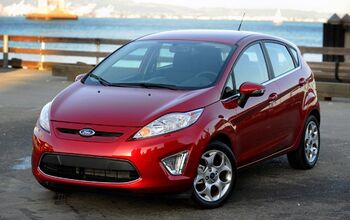
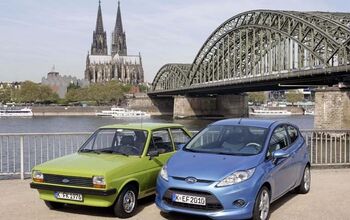




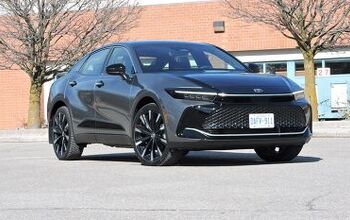
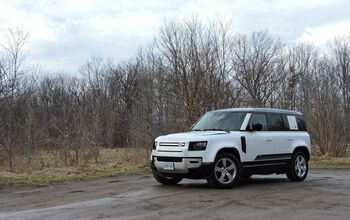
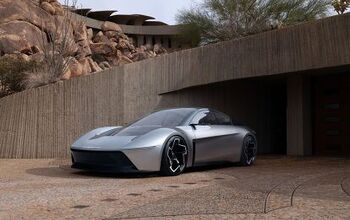

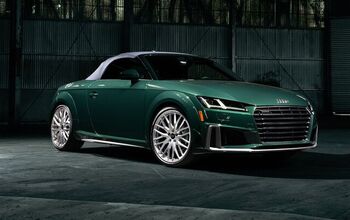
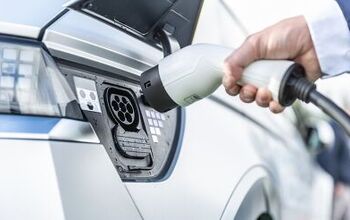
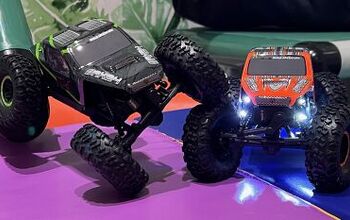
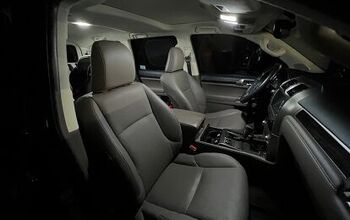
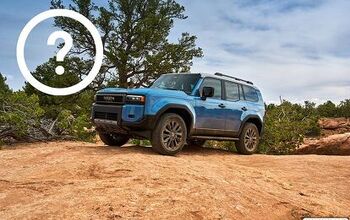
Comments
Join the conversation